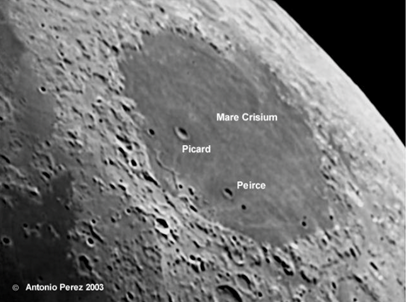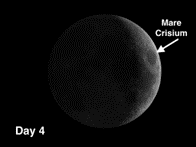The week of April 17-April 23 takes us from Day 27 to Day 4. This week we will highlight the craters Peirce & Picard, located in the western portion of Mare Crisium and viewable on Sunday evening.
 Peirce & Picard: [NE/H15; L=54°E] The two largest intact craters on Mare Crisium are Peirce and Picard. They are only about 12 miles in diameter by 1 mile deep and will require 75x – 100x to see them. They are located on a more-or-less north-south line about 30 miles in from the western shore of Crisium (Peirce is the northernmost). The lava that covered Crisium stopped flowing before these craters formed. You should easily be able to spot Swift, a small seven-mile crater just eight miles to the north of Peirce.
Peirce & Picard: [NE/H15; L=54°E] The two largest intact craters on Mare Crisium are Peirce and Picard. They are only about 12 miles in diameter by 1 mile deep and will require 75x – 100x to see them. They are located on a more-or-less north-south line about 30 miles in from the western shore of Crisium (Peirce is the northernmost). The lava that covered Crisium stopped flowing before these craters formed. You should easily be able to spot Swift, a small seven-mile crater just eight miles to the north of Peirce.
 Dorsum Oppel: [NE/H15; L=53°E] As the lava cooled following the impact that created Mare Crisium, a series of wrinkle ridges, known as Dorsum Oppel, formed along the entire western edge and give the impression of waves lapping on the shore. The flowing lava partially filled the pre-existing craters Yerkes and Lick [H15], turning them into ghost craters.
Dorsum Oppel: [NE/H15; L=53°E] As the lava cooled following the impact that created Mare Crisium, a series of wrinkle ridges, known as Dorsum Oppel, formed along the entire western edge and give the impression of waves lapping on the shore. The flowing lava partially filled the pre-existing craters Yerkes and Lick [H15], turning them into ghost craters.
There is also a more substantial ridge that connects the flooded crater Yerkes with the smaller Yerkes E, 15 miles to its northwest (unnamed on the Field Map). Under a low Sun, when the terminator is around 52°-55°, this ridge will combine with the SW rim of Yerkes to look remarkably like the silhouette of a bird in flight. It has consequently been nicknamed the Flying Eagle. (This feature may be seen to better advantage on Day 17 when the Sun is setting.)
OF ADDITIONAL INTEREST IN SPACE
Aristarchus1: [NW/G5] Aristarchus is the brightest spot on the Moon, a phenomenon that you can observe Sunday night when you may notice that you can see it even on the dark portion of the Moon! It is so bright that Sir William Herschel mistook it for an erupting volcano2.
1 Aristarchus of Samos: (310-230 BCE) Greek astronomer who was the first person to teach that the Earth revolved around the Sun and rotated on its axis, hence he is frequently referred to as the “Greek Copernicus.” (Tragically, most of his writings went up in flames when the Great Library at Alexandria was burned.) For his belief that the Sun was at the center of the Solar System, it was suggested by Cleanthes the Stoic that he should be punished for impertinence to the gods. (It took a while, but the idea eventually caught on. Eighteen hundred years later the monk Giordano Bruno was burned at the stake in Rome for making similar suggestions.)
2 William Herschel: 18th c. English astronomer who discovered Uranus.
======================
It is highly recommended that you get a copy of Sky and Telescope’s Field Map of the Moon, the very finest Moon map available for use at the telescope. It is available for $10.95 at www.skyandtelescope.com and on Amazon. All features mentioned in this blog will be keyed to the grid on the Field Map and will look like this: Plato: [NW/D9]
Credits:
Courtesy of Gray Photography of Corpus Christi, Texas
Lunar photos: NASA / USGS / BMDO / LROC / ASU / DLR / LOLA / Moon Globe. Used by permission
- Rupes Cauchy: A Best Known Fault on the Moon - July 22, 2024
- Moon Crater Schickard – Crater Floor has Stripes - July 15, 2024
- Moon Craters Langrenus and Vandelinus - July 8, 2024